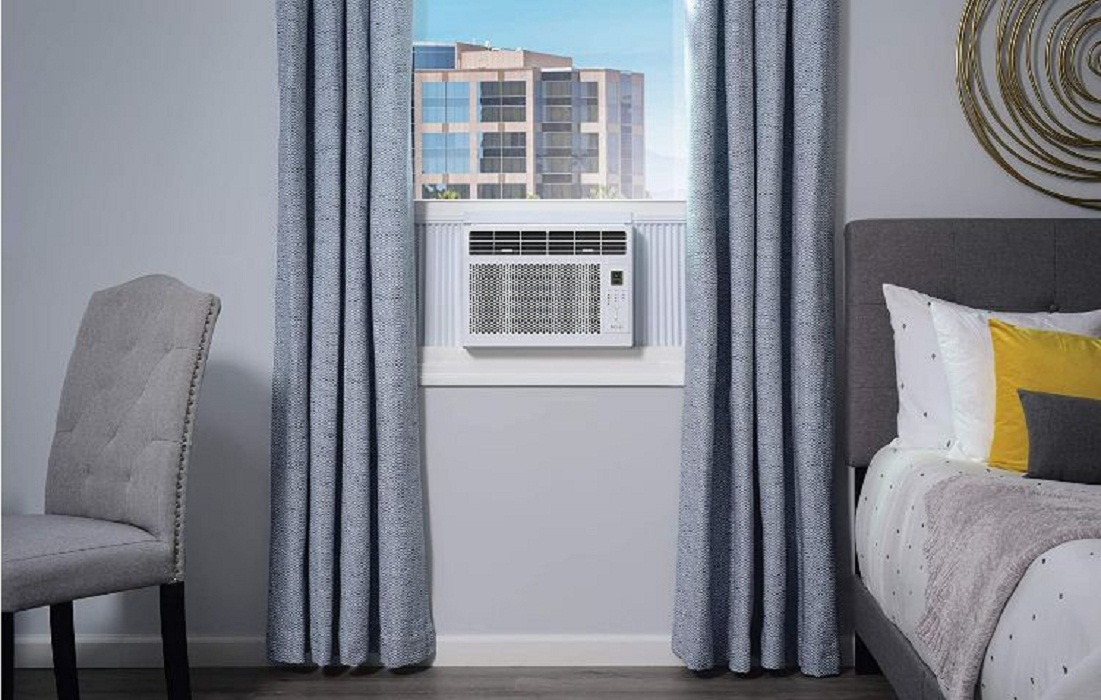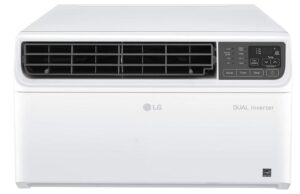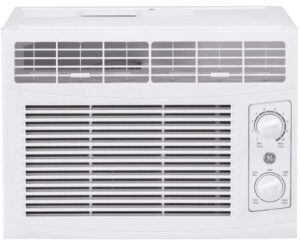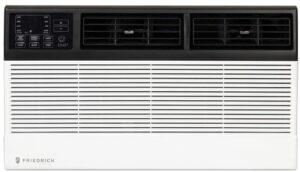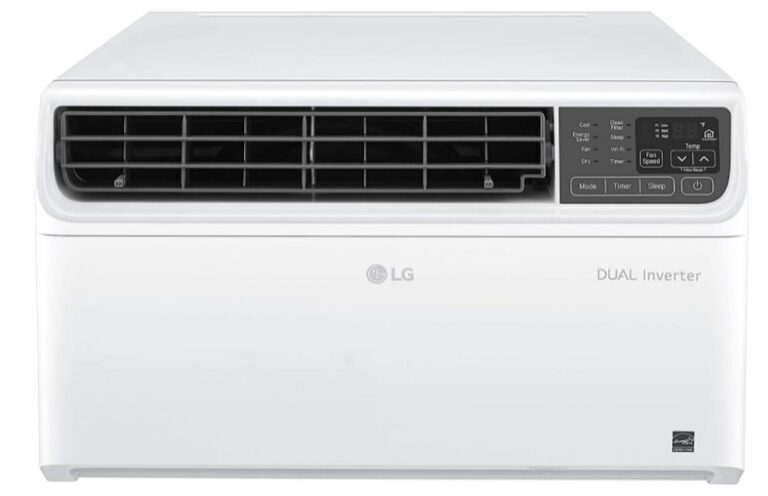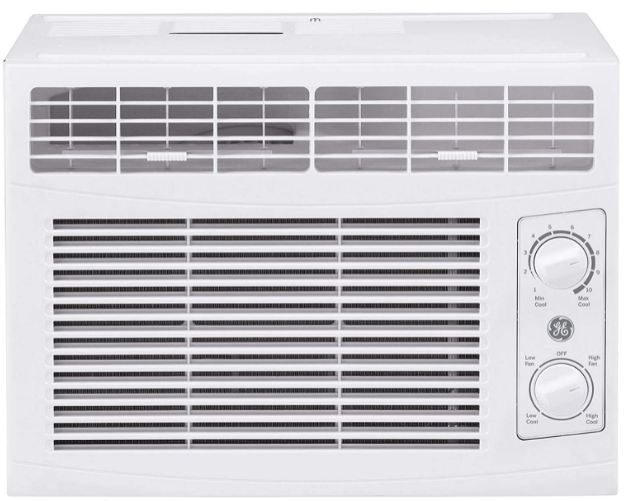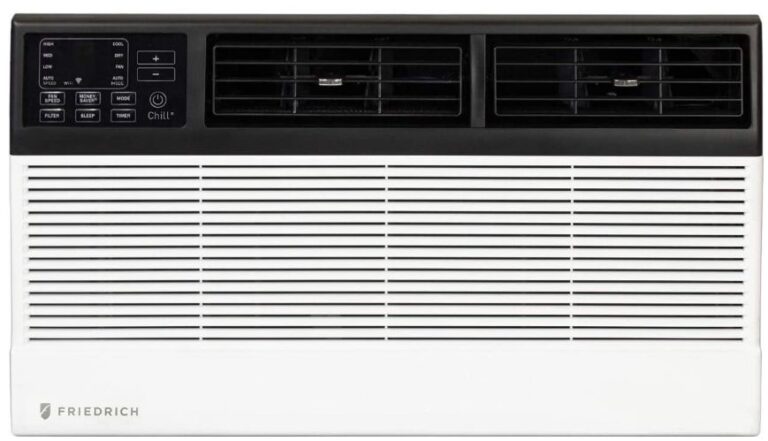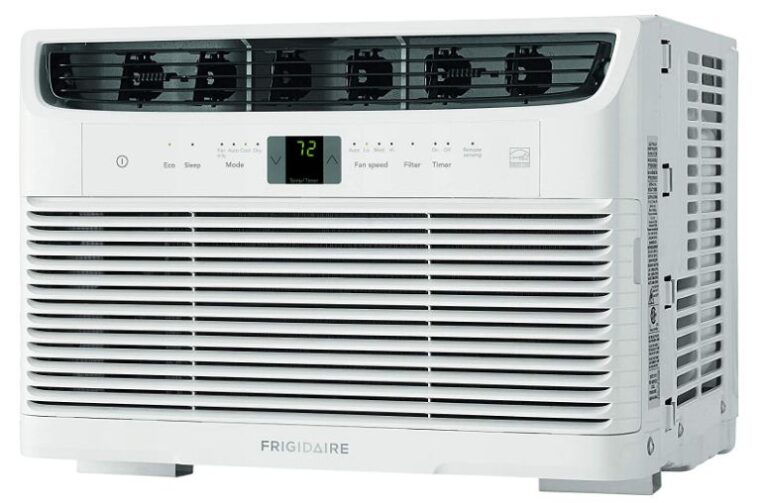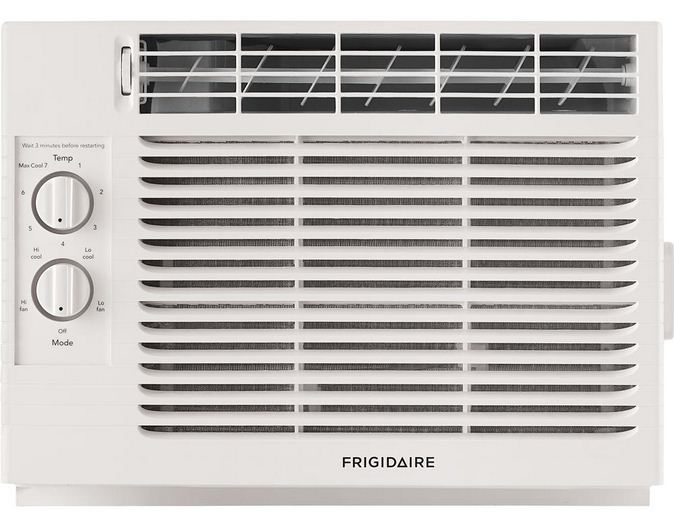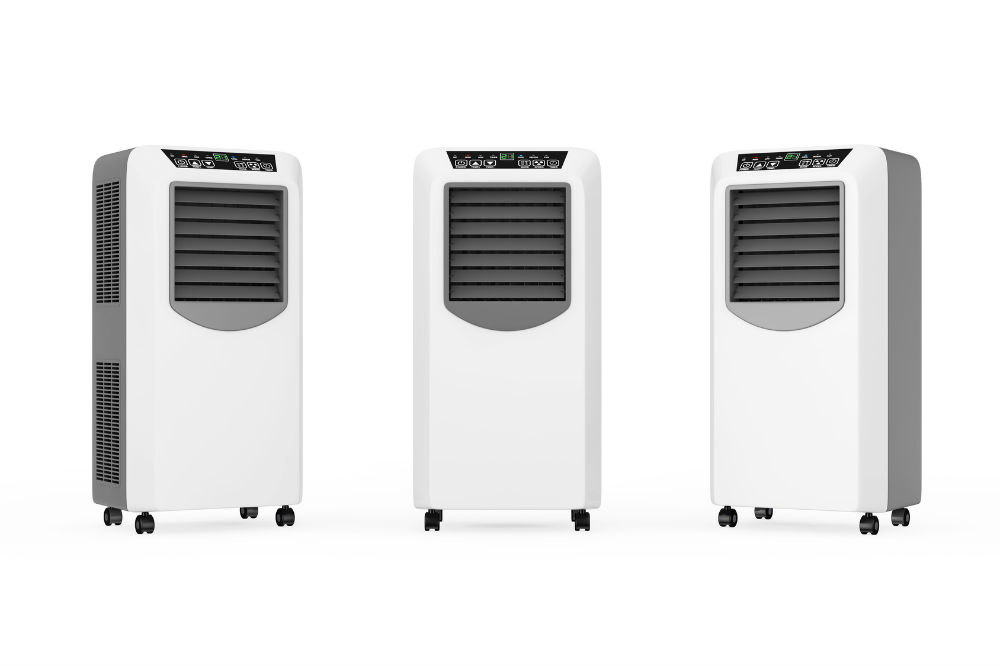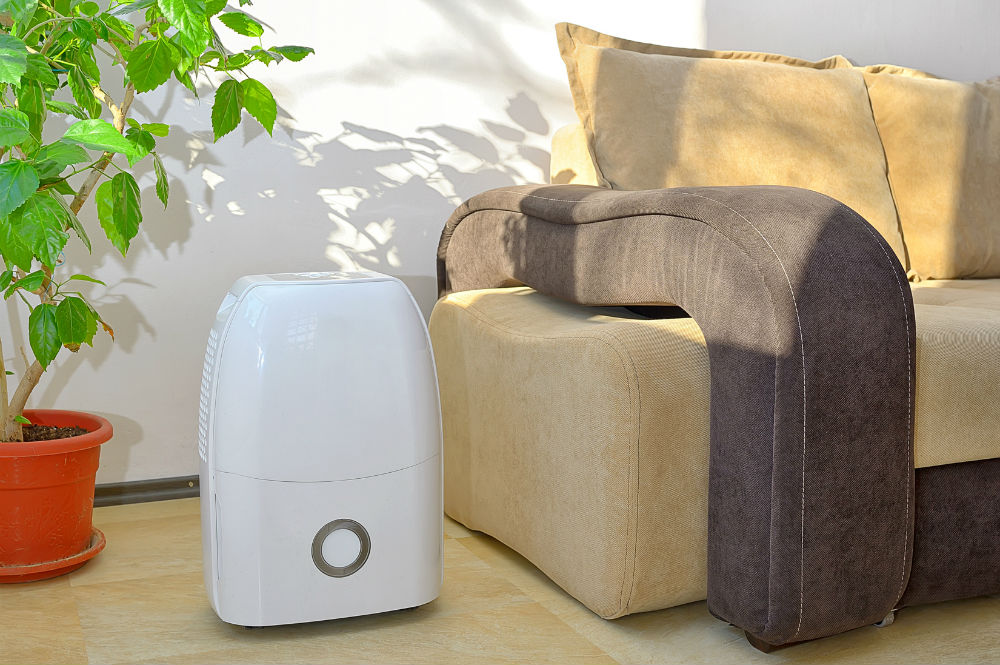Trying to decide which window AC brand & model to buy?
You’ve come to the right place.
If you lack a central HVAC system and/or want to cool a specific room, a window air conditioner is the least expensive, most efficient way to keep your cool.
Compared with other types of air conditioning systems, Window ACs are inexpensive, energy-efficient, and easy-to-install.
But to enjoy these benefits for a long time to come, it’s essential you invest in the right brand and model.
From newer popular brands Haier and LG to long-trusted AC brands GE and Frigidaire, there are countless models to choose from.
In this buying guide to window AC brands, we compare the leading brands and recommend a top pick from each to help you make a more informed choice.
So let’s dive in!
Best Window Air Conditioner Brands
Among the dozens of Window AC brands that sell on sites like Amazon and Alibaba, only a few have made a name for themselves by manufacturing dependable Window AC units – and are worth considering.
In our opinion, the best consumer window AC brands today include the following:
LG

LG is best known for manufacturing innovative and beautifully designed Window ACs.
The brand sells over 20 models with different features and size options, so you can surely find one for your needs.
LG incorporates the same technology in its window units that it uses for its mini-split AC. For example, the window AC units feature an efficient and quiet, inverter-driven compressor.
The brand is also one of the first to use R32 instead of R410A (known for its high global warming potential) in its window AC.
Most LG window AC come with convenient features like 3-way or 4-way air direction control, multi-speed fans, and 24-hour timers.
GE

General Electric produces just a handful of window AC units today, and all of them come with innovative features – which is why they lie on the higher end of the cost spectrum.
Instead of a true heat pump, GE models come with electric heaters.
Other features common to GE window units include 4-way air louvers, multiple-speed fans, timers, and remotes.
Friedrich

Friedrich also manufactures technologically advanced units known for being extremely quiet yet highly efficient, but they are slightly expensive. The company’s range includes models with a capacity of 5000 to 36000 BTUs. Most of them also feature a built-in smart Wi-Fi operation.
Friedrich has 3 different lines for window AC.
Its Kuhl smart room line includes 6000-35000 BTU models characterized by superior construction, built-in Wi-Fi, and voice command.
The Chill Premier smart window AC lineup also includes models integrated with voice command, Wi-Fi, Quietmaster technology, and commendable energy efficiency. AC units in this line range from 5000 BTUs to 24000 BTUs and are available in both heat/cool and cool-only options.
Lastly, Chill window AC units include stylish options at an affordable price. The models have a cooling capacity of 6000 to 24000 BTUs and are available in both cooling/electric heat and cool-only options.
Haier

Haier is another household name, and its window AC lineup ranges from 5000 to 24000 BTUs. Some of them are affordable knob-controlled options.
Haier Window AC come with standard features like directional airflow, multiple fan speeds, and 24-hour timers. Some also feature Wi-Fi connectivity.
Most Haier models are Energy Star certified.
Frigidaire

The Frigidaire lineup includes a variety of models ranging from affordable knob-controlled options to feature-rich and advanced digital AC.
The lineup also includes a few options for casement windows, which also makes the brand stand out.
Some Frigidaire models also feature ionizers to clean the air. Other features include supplemental heat, timers, Wi-Fi connectivity, and remote.
Kenmore

Kenmore is quite popular for manufacturing smart appliances that ease people’s life, and the same applies to their window AC.
The company makes technologically advanced and innovative window AC units that offer more than just standard features.
For example, many of their window ACs come with a Smart AC app. Once you install the app on your smartphone and set it up with the air conditioner, you can program your unit from anywhere. You can even set the speed and schedule it.
What's In This Buying Guide
Table of Contents
In this buying guide, we compare and contrast the top window AC brands and review some of their best-performing units.
We also discuss how to think about and choose the best window AC for your needs.
Finally, we discuss the ins and outs of how to install, clean, and maintain your window AC and answer a few commonly asked questions.
So let’s get to it.
Our Favorite 3 Window Units From The Best Brands
- Cooling capacity of 9500 BTU
- Cools rooms up to 450 sqft
- Works with Google and Amazon Alexa
- Cooling capacity of 5,050 BTU
- Cools rooms up to 150 sqft
- Inexpensive & energy-efficient
- Cooling capacity of 12000 BTU
- Cools rooms up to 450-550 sqft
- Energy Star certified + R-410A
Best Window ACs from the Best Brands
- 1. Best LG Window Air Conditioner: LW1019IVSM Dual-Inverter Window AC
- 2. Best GE Window Air Conditioner: GE Mechanical Window Air Conditioner
- 3. Best Friedrich Window Air Conditioner: Friedrich Chill Premier Smart Window AC
- 4. Best Haier Window Air Conditioner: Haier Window Electric AC
- 5. Best Frigidaire Window Air Conditioner: Frigidaire Mini-Compact Window AC
- 6. Best Kenmore Window Air Conditioner: Kenmore 87050
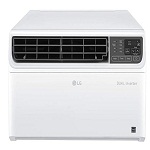
LG LW1019IVSM Dual-Inverter Window
Best LG Window Air Conditioner
450 sq ft
9500 BTU
4 Cooling Speeds
Remote Control
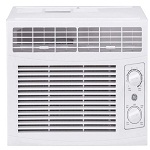
GE Mechanical Window Air Conditioner
Best GE Window Air Conditioner
150 sq ft
5050 BTU
2 Cooling Speeds
Remote Control
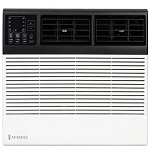
Friedrich Chill Premier Smart Window AC
Best Friedrich Window Air Conditioner
450-550 sq ft
12000 BTU
3 Cooling Speeds
Remote Control
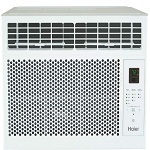
Haier Window Electric AC
Best Haier Window Air Conditioner
250 sq ft
6000 BTU
3 Cooling Speeds
Remote Control
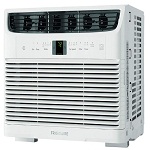
Frigidaire Mini-Compact Window AC
Best Frigidaire Window Air Conditioner
150 sq ft
BTU
50002 Cooling Speeds
Remote Control
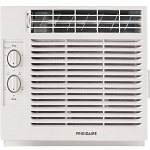
Kenmore 87050
Best Kenmore Window Air Conditioner
150 sq ft
5000 BTU
2 Cooling Speeds
–
Featuring a cooling capacity of 9500 BTU, the LG LW1019IVSM can cool medium rooms of up to 450 square feet. It has 4 fan and cooling speeds with Auto Cool so you can customize your cooling.
The LW1019IVSM is 15% more energy-efficient than what the Energy Star certification requires, saving you both money and energy.
The window AC features dual inverter technology that delivers a powerful but silent performance. In fact, in the sleep mode, it makes only 44dB of sound.
Plus, with the LG ThinQ Technology, you can control this LG window air conditioner from anywhere. You can turn the device on and off, change the mode, or even set the temperature.
The AC also works with Hey Google and Amazon Alexa, so you can adjust the settings using voice commands.
PROS
- Compressor doesn’t make annoying buzzing sounds
- No vibrations or rattling
- Excellent cooling power
- Works with the LG ThinQ app
- Cools the room very quickly
CONS
- The “L” support brackets don’t fit some windows
The GE Mechanical window AC has a cooling capacity of 5,050 BTU for small spaces of up to 150 square feet.
It is quite energy-efficient and has 2 fans and 2 cooling speeds to provide flexible home comfort.
It is also easy to install. It has a fixed chassis and comes with an EZ Mount installation kit that makes it easy to install in a double-hung window.
This GE window air conditioner also has mechanical controls to easily manage and adjust the settings. It also has an adjustable thermostat and an easy-to-clean slide-out filter.
It also features 2-way adjustable louvers to evenly distribute air throughout the room.
The GE window AC fits windows 13⅜” high and 12⅞”-36” wide.
PROS
- Large dials make it easy to use in the dark
- Instructions are very easy to follow
- You can control it via the app and remote
- Seals really well
CONS
- Makes a noticeable sound on the loudest setting
The Friedrich Chill Premier 12000 BTU AC can cool spaces of 450-550 square feet.
It is designed with what the company calls QuietMaster Technology that makes sure that the AC is 25% quieter than other models.
It also comes with other features that reduce noise. For instance, insulation on the inner wall absorbs sound, while metal casing blocks out external noise.
Similarly, counterweights decrease sound and dampen vibration, while wide air discharge vents minimize the noise made by the front panel and optimize airflow.
The Friedrich window AC also comes with built-in Wi-Fi. You can control the AC with the Friedrich Go App on your smartphone. You can even control it with voice commands!
The Chill Premier AC comes with 3 cooling and fan-only speeds, a unique sleep setting, and 8-way airflow control.
It also comes with a ‘check filter’ alert and a washable antimicrobial air filter to maintain fresh air in your house.
Lastly, it is Energy Star certified and uses the R-410A refrigerant.
PROS
- Easy to install
- Compact for a 12000 BTU unit
- It allows you to set a schedule
- Works with voice commands without any problems
CONS
- The accordion filter is not long enough to fill gaps on the sides
- It’s loud
The Haier Electric window AC has a 6000 BTU cooling capacity and cools small spaces up to 250 square feet. It is also energy-efficient and has 3 fan and cooling speeds.
One distinguishing feature of the Haier window AC is the Energy Saver mode. Once the room cools down enough, the Energy Saver mode automatically shuts down the compressor and fan, thus saving both money and energy.
It is also easy to install. It has a fixed chassis and comes with an EZ Mount installation kit to easily install a double-hung window.
The Haier window AC also comes with an electronic thermostat and a remote that make it easy to adjust your settings from anywhere in the room.
PROS
- Economical, efficient, quiet
- The filter is on the left side, making it easier to clean
- Air exit and coil are easy to clean
- Fits in a sliding window
CONS
- Makes a lot of noise
Frigidaire mini-compact window AC has a cooling capacity of 5000 BTU and is ideal for spaces up to 150 square feet.
It has 2 fan speeds, 2 cooling speeds, and a 24-hour timer.
The mini-compact AC cools down the room in just a few minutes. Plus, the low power operation and start-up help save both money and energy.
The Frigidaire Mini-Compact AC also comes with Ready-Select electronic controls that allow you to set the comfort level you prefer. And a temperature readout displays the temperature you set.
The AC also comes with a full-function remote control that lets you control the fan speed and temperature precisely from across the room.
In addition, the 4-way air direction lets you direct air wherever you want. Plus, the washable filter with tilt-out access filters out dust to keep the AC working efficiently.
Lastly, the Effortless Restart feature makes sure the AC operates at the previous setting after a power outage.
PROS
- Makes soothing background noise
- Works great in rooms with high ceilings as well
- Energy-efficient and Energy Star compliant
- Reasonably quiet
CONS
- It’s very heavy, so it makes installation a little difficult
- Airflow direction is limited
The Kenmore 87050 is a 5000 BTU unit and quickly cools down rooms up to 150 square feet.
It has a removable antimicrobial filter that eliminates harmful bacteria from the indoor air.
The 87050 has a low-power start-up. Plus, the Effortless Restart feature restores operation at the previous settings once power is restored.
The Kenmore window AC also has a Quick Warm & Quick Cool mode. With this mode, you can speed up the fan and warm up or cool down the space faster.
In addition, it has an Effortless Temperature Control, which allows the AC to maintain the room temperature you preset.
Lastly, it has SpaceWise adjustable side panels that expand to fill up the gaps in the window.
PROS
- Has an antimicrobial filter
- Comes with an extra-long 3-prong cord, so you don’t need an extension cord
- Remembers your programmed settings
- Makes 51-55 dB of sound
CONS
- Doesn’t have a timer
- No remote control
Buying Guide: How to Choose the Best Window Air Conditioner
Energy Star Rating
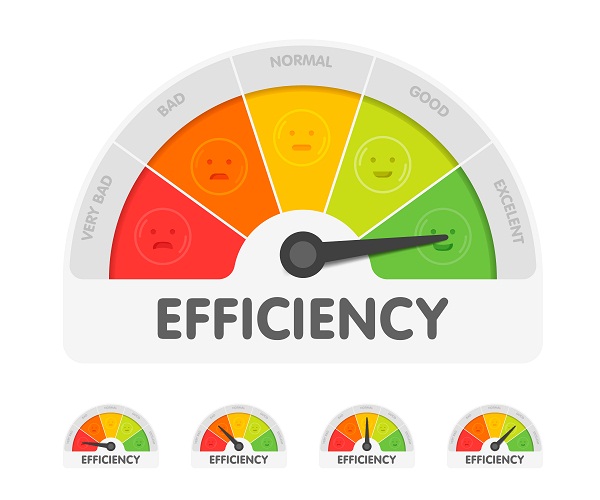
Since October 2015, all Energy Star-rated window AC units meet the Energy Star 4 standard that sets the units’ power use at 10% less than older models.
Old models with a low energy efficiency rating are cheaper, but they drive up energy bills and are costly to maintain.
Meanwhile, relatively newer models with an EER rating of 10 or more are expensive, but they are energy efficient and hardly need costly maintenance, making them an investment.
Cooling Capacity (BTU)
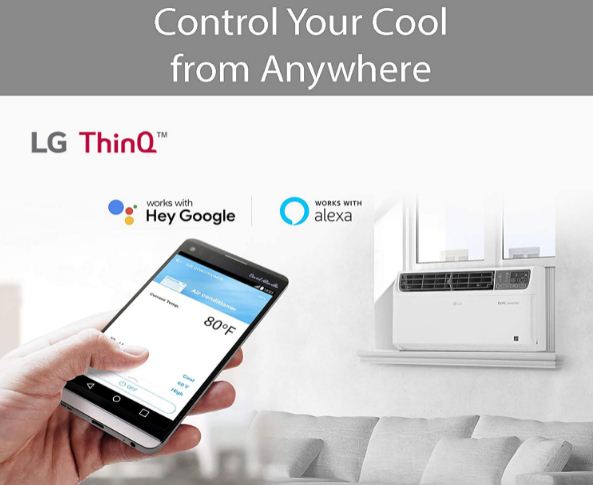
The cooling capacity of an AC is measured in BTU and depends on the room’s size. For every square foot of space that you want to cool, you should ideally go for 20 BTU.
You might be tempted to get an AC with a higher BTU for a small space, but that might be counterproductive. Yes, it will cool down your room quickly, but it won’t get rid of the humidity. An AC with a lower BTU will take more time to cool down the room, but it will also take care of the humidity.
Meanwhile, a low BTU AC in a big room will just be a waste of energy.
Coverage Area
We advise you to measure the window size and estimate the square footage of the space or room you want to install the AC in so that you choose the right option.
Here’s a chart with a rough estimate of the BTUs you need depending on your room’s size.
Room size | BTU |
100-150 square feet | 5,000 |
150-250 square feet | 6,200 |
250-300 square feet | 7,000 |
300-350 square feet | 8,000 |
350-400 square feet | 9,000 |
400-450 square feet | 10,000 |
450-550 square feet | 12,000 |
550-700 square feet | 14,000 |
700-1000 square feet | 18,000 |
1000-1200 square feet | 21,000 |
1200-1500 square feet | 24,000 |
1500-2000 square feet | 30,000 |
2000-2500 square feet | 35,000 |
Remember, this table is only a rough estimate and assumes only 2 occupants. Add in 600 BTU of cooling power for each additional person.
When sizing the window AC, there are a few other things you should consider.
For instance, if your room gets direct sunlight, it’s better to increase the BTUs by 10%. Similarly, reduce the AC’s capacity by 10% for heavily shaded parts of the house.
And if the AC will cool a kitchen, make sure to add 4000 BTUs to the capacity.
Refrigerant (R410A or R32)
Since 2006, the majority of new AC units use the R-410A refrigerant instead of the ozone-depleting R22 refrigerant.
Today, R32 is also available.
R-410A doesn’t damage the ozone layer, and it has a global warming potential of 2088. R32 also doesn’t damage the ozone layer, but it has a much lower global warming potential of 675.
In comparison to R-410A, R32 also improves energy efficiency by up to 10%.
And while AC units that use R32 are relatively more expensive, they have roughly one-third the environmental impact of units with R410A.
Window Type
Window type is another important consideration.
Windows can usually be divided into 3 categories:
- Standard windows that open up and close down
- Slider windows that you open by sliding the panel to the side
- Casement windows that swing-out
The installation kit you get with most air conditioners works with both standard and slider windows. But if you plan to install an AC on a casement window, look for a unit that is compatible with that window style.
Warranty & Durability
Before you finalize your purchase, check for the warranty that the manufacturer offers. Keeping in mind that your AC is going to serve you for 8-10 years, it’s better to opt for an extended warranty to minimize the risk of unforeseen expenses.
A long warranty also means that the manufacturer trusts its unit to work well for years without causing any problems. So, you can know how durable the unit is by checking out the unit’s warranty coverage.
Another way to ensure durability is to check out what other verified users have to say about the AC.
Price

The price of window air conditioners depends on their cooling capacity and the area they cover.
Small AC with a 5000-6500 BTU capacity cost roughly $180 to $350 and cover around 100-300 square feet.
Medium-capacity air conditioners with a BTU rating of 7000-8200 cost anywhere between $250 and $400 and can cover up to 400 square feet.
Large-capacity air conditioners range from 9800 BTU to 12500 BTU and cost around $350 to $600.
Low Maintenance
Window AC are usually low maintenance. Servicing them is also quite simple since all the components are compactly designed.
You can check if your AC is also low maintenance by looking at what verified users have to say about its maintenance.
Remote Control

A remote controller lets you adjust the settings and control the air conditioner (turn it on or off) even from across the room.
In some cases, the remote also works as a portable temperature sensor to make sure the room is evenly cooled. The remote activates the AC as soon as the air around it reaches a pre-specified temperature.
Adjustable Fan Speed
The fan speed lets you set the rate at which the device will cool down the room.
Cheaper air conditioners usually with 2 fan speeds, high and low, while high-end units feature 3-4 fan speeds (auto, high, medium, low).
Remember that the number of fan speeds that an AC has becomes less important the longer it operates. Once the room cools down, only the low setting is enough to maintain a cool, comfortable temperature.
The auto speed is a convenient option as it automatically adjusts the fan speed and maintains the right temperature. The auto mode is also energy efficient and helps save money.
Noise Level
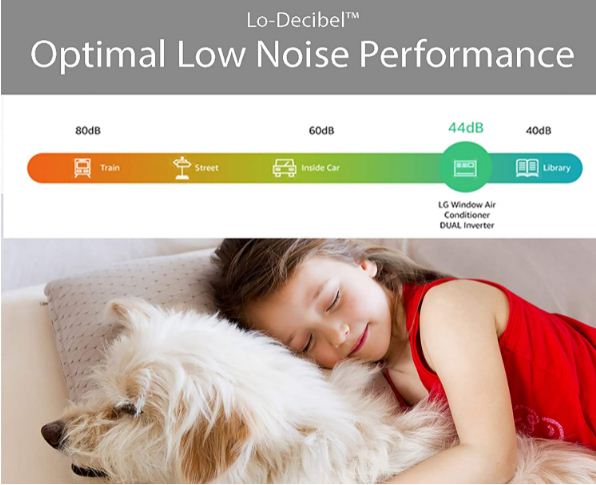
While you can easily fix the sounds coming from Window AC, which primarily arise due to problems like a lack of lubrication on the motor, a loose front grill, vibrations from the window, and bent fan blades, you can’t really do much about a window AC making a lot of noise as long as it is turned on and running.
Some window air conditioners are just annoying and loud. So, if you can’t handle some background noise, make sure you check the decibel level of the AC before buying it. This is especially important if you plan to install the AC in a quiet room like the library or your bedroom.
Some brands like Frigidaire, LG, and Friedrich pride themselves in manufacturing some of the most silent AC units.
Air Direction Control
Most Window ACs blow air in one direction.
However, a window AC will serve you better if it directs air towards the center of the room.
So, before you make the purchase, check if your AC has adjustable louvers.
Programmable Thermostat
A thermostat allows you to control your AC’s output temperature.
Some budget models come with a mechanical thermostat that has a dial you rotate to set the desired room temperature. This dial has a few numbers for the coldness settings (like 1 to 5) instead of degrees.
But most high-end models come with a digital thermostat that is not only highly accurate but also keeps the temperature consistent. With a digital thermostat, you can select a specific degree setting.
Programmable Timer
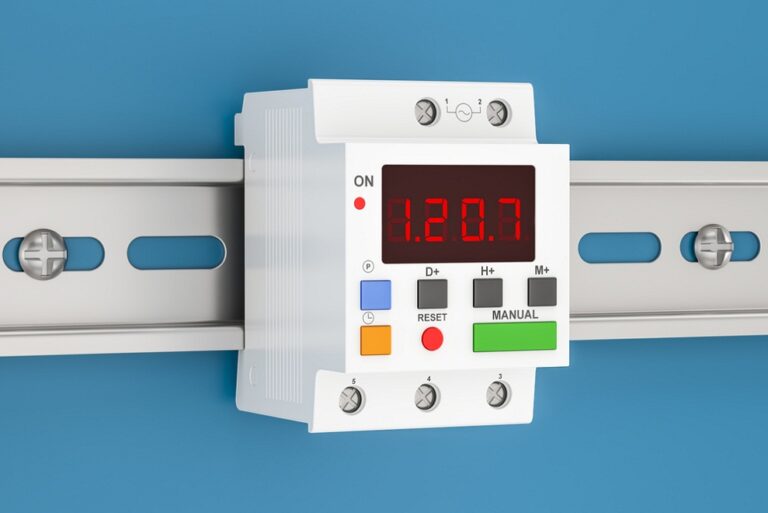
A programmable timer lets you plan how the air conditioner runs and when to turn it on and off. This way, you can conserve energy by shutting off the AC when no one is around.
And instead of leaving the air conditioner switched on throughout the day, you can even program it to turn on 30 minutes before you usually come back home.
Cheap models only have pre-set intervals, like 12, 8, 4, or 2 hours for when the AC should turn off, while more premium models allow you to program certain stop and start times throughout the day. In fact, you can even set up some 24 hours in advance.
Filter Alert System
Window AC usually have a filter alert system in the form of a digital notification or a light indicator. This system tells you when the filter needs cleaning.
A dirty filter lowers the AC’s efficiency as it makes the AC work hard, which is why it’s essential to clean it in time.
A clean filter also ensures cleaner indoor air, so make sure you opt for a model with a filter alert system.
Installation of Window Air Conditioners
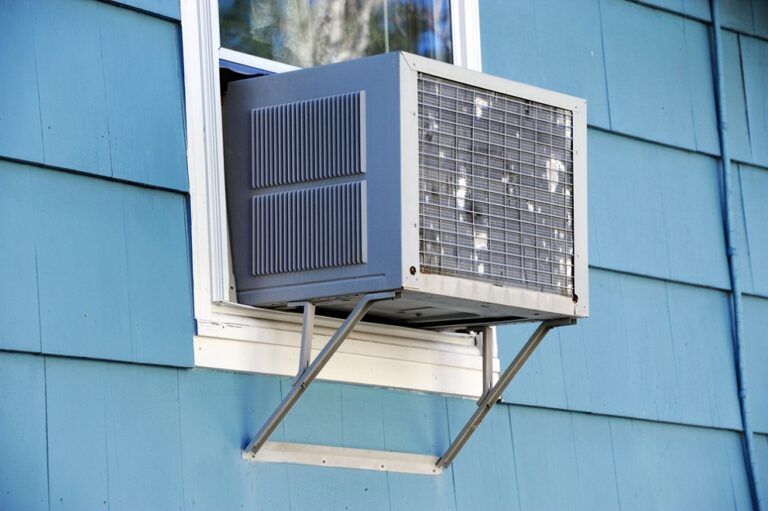
The installation of window AC units depends on the type of window.
Almost all models are designed for double-hung windows that have vertical window sliders.
The sliding pane sits behind the bracket and provides a secure brace to prevent the AC from falling out of the window. Most AC units also come with expanding baffle wing curtains that make it easy to fill up the gaps on either side of the model.
The installation itself is quite easy and simple. Generally, most window sills support the AC and don’t require you to make any changes. Still, installation kits come with brackets or include tips to add bracing if your storm window keeps the AC from sitting well.
Then, you just need to make sure that the included foam sealing is in place and attach the wings to fill the gaps.
Next comes the hardest part: hosting the AC in place, and it’s better if you have a helping hand. Rest the AC in the frame and ask a helper to steady it. Then, slide the inside window sash in its place to secure the air conditioner.
After that, you only need to add stop-braces to ensure no one accidentally opens the window. Finally, use tape and insulating panels to close any remaining gaps so that the cold air doesn’t escape the room.
In the case of a horizontal sliding window, you need a shelf or a brace against your exterior wall to secure the unit.
Installing an air conditioner on a casement window is the trickiest part, even though AC models designed for horizontal slides are usually also designed for casement windows.
For detailed installation instructions, make sure you check out the unit’s user manual.
Why buy a Window AC over Central HVAC?
The most practical reason for buying a window AC instead of a central HVAC is, of course, the costs involved. It is much cheaper to purchase, install, and maintain a window AC compared to a central HVAC.
You can get a high-quality central HVAC system for roughly $1500, but when you factor in the installation, maintenance, and operation cost, the total can go as high as $10,000.
Meanwhile, you can easily get a window AC for around $2000 to $600 with monthly operating costs of around $30-$80, depending on your use.
Installing a window AC is pretty easy. You only need a window, and you can even install the unit yourself without professional help. All you need to do is follow the manufacturer’s instructions.
However, installing an HVAC system is costly and complex. You need to have a large budget to be able to install vents around the house (this can easily cost up to $5000).
Plus, modern window AC models work as heaters as well.
Pros and Cons of using a Window AC
Pros
- Window AC have lower upfront costs and usually don’t require professional installation.
- They are a cost-effective solution for small spaces, like workshops, offices, and apartments.
- The market is full of options, so it’s easy to find a unit that meets your budget.
- Window AC models are energy-efficient and not too noisy
- Water directly drains from the AC to the exterior without you having to intervene.
- Even small models can cool up to 300 square feet, and if you place them carefully, one unit can cool multiple rooms.
Cons
- Not the best option for excessively hot climates.
- A window AC blocks the window and obscures the view.
- Water that drains from the unit might rot or stain the home’s siding.
- Intruders can get into your house through the partially opened window.
- Shifting and moving the AC from one room to another is quite tricky.
- Most window AC models are quite clunky and ruin the aesthetic of the room.
Cleaning and Maintenance of Window AC
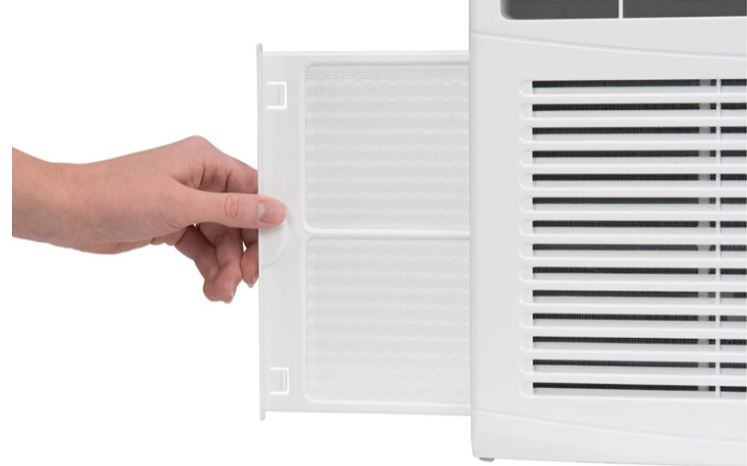
Regular maintenance can keep your window AC efficient for years.
To maintain your unit regularly:
1. Clean or replace the filter as specified by the manufacturer.
Clean filters not only keep the AC efficient but also reduce dust.
You can extend the life of AC filters by vacuuming them or washing them with mild soap and water. Make sure they are completely dry before you install them.
Also, make sure you wipe the cabinet gently. Make sure you turn the unit off before doing any maintenance.
2. Store properly
If you plan to store the window AC for the winter season, make sure you follow the manufacturer’s instructions.
Final Verdict: What is the best Window AC brand sold today?
There are many top window AC brands with excellent models, making it difficult to choose one.
But names like LG, Haier, and Kenmore are household names you can trust.
So, before you opt for a brand, make sure you go through verified customer reviews and the brand’s warranty policy to make a sound investment.
I’m a degreed ME (mechanical engineer) who is passionate about machines of all kinds. I created MachineWonders.com as a way to connect with others who love machines like me – or need help choosing one for their needs, application, or situation.

